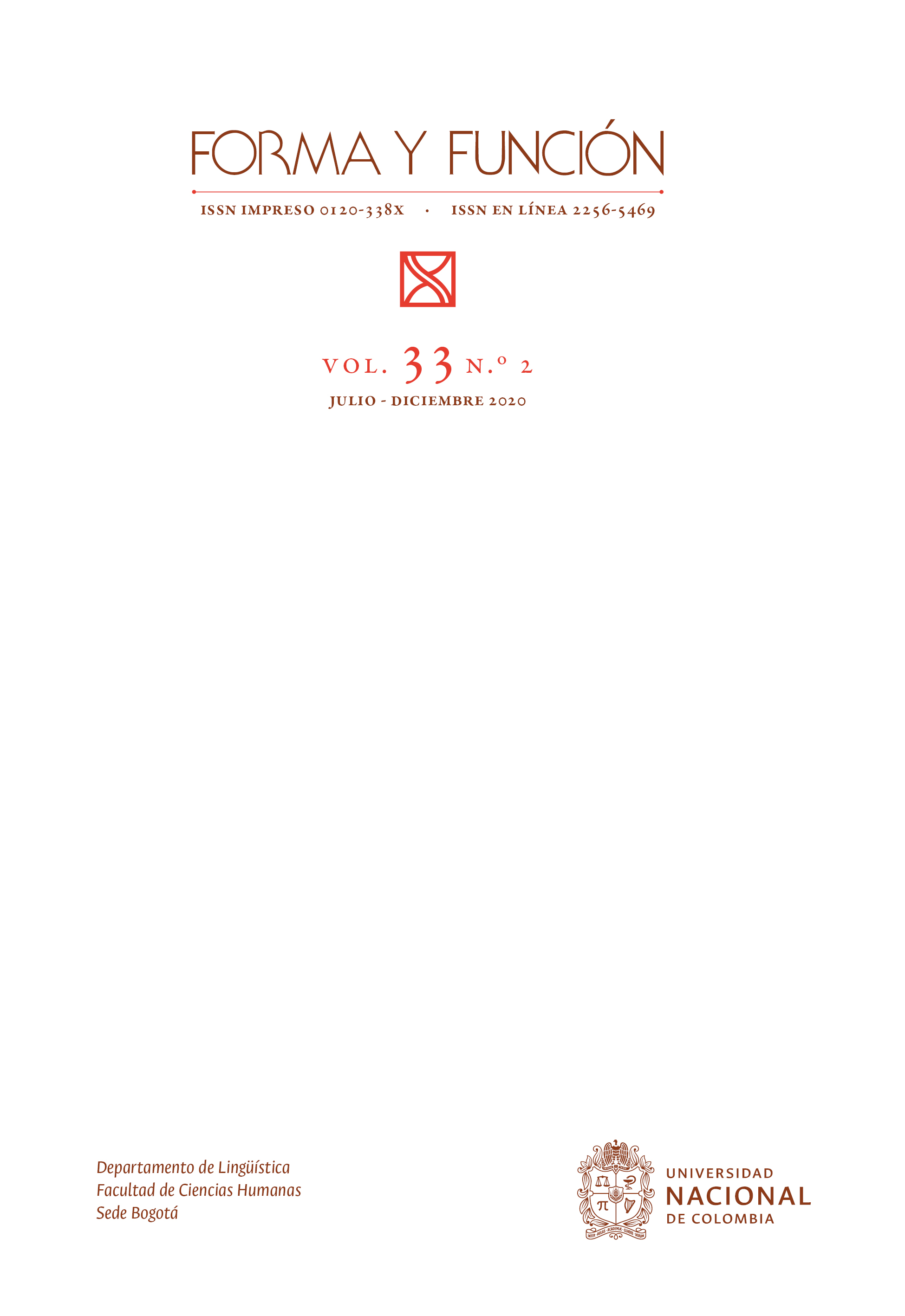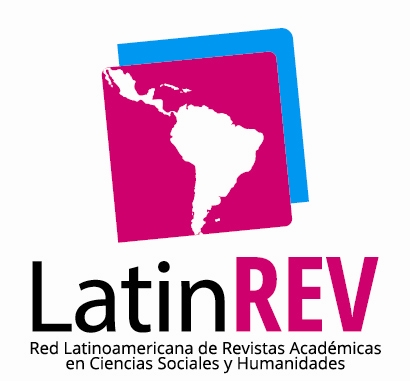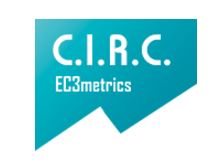Sujetos nulos: tipología lingüística, adquisición y contacto de lenguas
Null Subjects: linguistic typology, acquisition, and language contact
Sujeitos nulos: tipologia linguística, aquisição e contato de línguas
DOI:
https://doi.org/10.15446/fyf.v33n2.79774Palabras clave:
adquisición, contacto, tipología, sujetos expresos, sujetos nulos (es)acquisition, contact, typology, expressed subjects, null subjects (en)
aquisição, contato, tipologia, sujeitos expressos, sujeitos nulos (pt)
Descargas
El siguiente artículo ofrece un recuento de las principales propuestas y modelos formulados para explicar la variación en la expresión de sujeto a través de las lenguas. El tema es abordado desde las perspectivas de la teoría lingüística, la lingüística tipológica, la adquisición de primeras y segundas lenguas, y el contacto de lenguas. En él se incluyen también nuevas hipótesis junto a posibles formas de comprobarlas, así como posibles implicaciones que estas pueden tener para la lingüística y las disciplinas afines. En particular, este artículo puede ser de utilidad para que investigadores de diversas disciplinas se familiaricen con el estado del arte de la expresión de sujeto, conozcan nuevas direcciones de investigación y se animen a ser parte de proyectos relacionados.
The article presents an account of the main proposals and models put forth to explain the variation in the expressed subjects in languages. One deals with the topic from the viewpoints of linguistic theory, linguistic typology, first and second language acquisition, and language contact. One discusses new hypotheses, possible ways to prove them, as well as the ramifications they can have for linguistics and related disciplines. This article may prove useful for researchers from several disciplines, who are interested in finding out about the state of the art on expressed subjects, and new directions in research, and who are willing to participate in related projects.
O artigo a seguir oferece um registro das principais propostas e modelos formulados para explicar a variação na expressão de sujeito através das línguas. O tema é abordado a partir das perspectivas da teoria linguística, da linguística tipológica, da aquisição de primeiras e segundas línguas, e do contato de línguas. Nele, são incluídas também novas hipóteses com possíveis formas de comprová-las, assim como possíveis implicações que estas podem ter para a linguística e as disciplinas afins. Particularmente, este artigo pode ser de utilidade para que pesquisadores de diversas disciplinas se familiarizem como o estado da arte da expressão de sujeito, conheçam novos caminhos de pesquisa e se animem a ser parte de projetos relacionados.
Referencias
Alfaraz, G. G. (2015). Variation of Overt and Null Subject Pronouns in the Spanish of Santo Domingo. En A. M. Carvalho, R. Orozco, & N. L. Shin (Eds.), Subject Pronoun Expression in Spanish: A Cross-Dialectal Perspective (pp. 3-16). Washington D. C.: George Town University Press.
Al-Kasey, T., & Pérez-Leroux, A. T. (1998). Second Language Acquisition of Spanish Null Subjects. En S. Flynn, G Martohardjono, & W. O’Neil (Eds.), The generative study of second language acquisition (pp. 161-186). Hillsdale: Lawrence Erlbaum.
Barbosa, P. (2010). Overt subjects in raising and control complements and the null subject parameter. Linguistic Society of America Annual Meeting, 1(Supp. 1), 33. doi: https://doi.org/10.3765/exabs.v0i0.512
Belleti, A., Bennati E., & Sorace, A. (2007). Theoretical and Developmental Issues in the Syntax of Subjects: Evidence of Near-Native Italian. Natural Language & Linguistic Theory, 25, 657-689. doi: https://doi.org/10.1007/s11049-007-9026-9
Camacho, J. A. (2013). Null Subjects. Cambridge: Cambridge University Press. doi: https://doi.org/10.1017/CBO9781139524407
Camacho, J. A., & Elías-Ulloa, J. E. (2010). Null subjects in Shipibo switch-reference systems. En J. A. Camacho, R. Gutiérrez-Bravo, & L. Sánchez (Eds.), Information structure in indigenous languages of the Americas: Syntactic approaches (pp. 65-85). Berlín-Nueva York: Mouton de Gruyter.
Cameron, R. (1993). Ambiguous agreement, functional compensation, and non-specific tú in the Spanish of San Juan, Puerto Rico and Madrid, Spain. Language Variation and Change, 5, 305-334. doi: https://doi.org/10.1017/S0954394500001526
Carvalho, A. M., & Child, M. (2011). Subject Pronoun Expression in a Variety of Spanish in Contact with Portuguese. En J. Michnowicz, & R. Dodsworth (Eds.), Selected Proceedings of the 5th Workshop on Spanish Sociolinguistics (pp. 14-25). Somerville: Cascadilla Proceedings Project.
Chomsky, N. (1981). Lectures on Government and Binding. Dordrecht: Foris.
Chomsky, N. (1993). A minimalist program for linguistic theory. En K. Hale, & S. J. Keyser (Eds.), The view from Building 20 (pp. 1-52). Cambridge: mit Press ma.
Christianson, K., & Cho, H. Y. (2009). Interpreting null pronouns (pro) in isolated sentences. Lingua, 119(7), 989-1008. doi: https://doi.org/10.1016/j.lingua.2008.11.005
Clements, M., & Domínguez, L. (2017). Reexamining the acquisition of null subject pronouns in a second language. Linguistic Approaches to Bilingualism, 7(1), 33-62. doi: https://doi.org/10.1075/lab.14012.cle
Costa, J., & Pratas, F. (2013). Embedded null subjects in Capeverdean. Journal of Linguistics, 49(1), 33-53. doi: https://doi.org/10.1017/S0022226712000217
De La Rosa Yacomelo, J. (2019). Null Subjects in Palenquero: Do they really exist? International Journal of Linguistics, Literature, and Translation, 2(4), 190-202.
Dryer, M. S. (2013). Expression of Pronominal Subjects. En M. S. Dryer, & M. Haspelmath (Eds.), The World Atlas of Language Structures Online. Leipzig: Max Planck Institute for Evolutionary Anthropology. Recuperado de http://wals.info/chapter/101
Duarte, M. E. (1995). A Perda do Princípio “Evite pronome” no Português Brasileiro (Tesis de doctorado). UNICAMP, Brasil.
Duguine, M. (2017). Reversing the Approach to Null Subjects: A Perspective from Language Acquisition. Frontiers in Psychology, 8(27). doi: https://doi.org/10.3389/fpsyg.2017.00027
Frascarelli, M. (2007). Subjects, topics and the interpretation of referential pro. An interface approach to the linking of (null) pronouns. Natural Language and Linguistic Theory, 25, 691-734. doi: https://doi.org/10.1007/s11049-007-9025-x
Frazier, L. (2015). Do null Subjects (mis-)Trigger Pro-drop Grammars. Journal of Psycholinguistics, 44, 669-674. doi: https://doi.org/10.1007/s10936-014-9312-8
Geeslin K., Linford, B., & Fafulas, S. (2015). Variable Subject Expression in Second Language Spanish. En A. M. Carvalho, R. Orozco, & N. L. Shin (Eds.), Subject Pronoun Expression in Spanish: A Cross-Dialectal Perspective (pp. 191-209). Washington D. C.: George Town University Press.
Haznedar, B. (2010). Transfer at the syntax-pragmatics interface: Pronominal subjects in bilingual Turkish. Second Language Research, 26(3), 355-378. doi: https://doi.org/10.1177/0267658310365780
Holmberg, A., Nayudu, A., & Sheehan, M. (2009). Three partial null-subject languages: A comparison of Brazilian Portuguese, Finnish and Marathi. Studia Lingüística, 63(1), 59-97. doi: https://doi.org/10.1111/j.1467-9582.2008.01154.x
Hyams, N. (1989). The Null Subject Parameter in Language Acquisition. En O. Jaeggli, & K. J. Safir (Eds.), The Null Subject Parameter (pp. 215-238). Dordrecht: Kluwer Academic Publishers. doi: https://doi.org/10.1007/978-94-009-2540-3_7
Hyams, N., Mateu, V., Ortfitelli R., Putnam, M., Rothman, J., & Sánchez, L. (2015). Parameters in language acquisition and language contact. En A. Fábregas, J. Mateu, & M. Putnam (Eds.), Contemporary linguistic parameters (pp. 352-373). Bloomsbury: Bloomsbury Publishing.
Jaeggli, O., & Safir, K. J. (1989). The Null Subject Parameter and Parametric Theory. En O. Jaeggli, & K. J. Safir (Eds.), The Null Subject Parameter (pp. 1-44). Dordrecht: Kluwer Academic Publishers. doi: https://doi.org/10.1007/978-94-009-2540-3
Jiménez-Fernández, A. (2016). When discourse met null subjects. Borealis, 5(2), 173-189. doi: https://doi.org/10.7557/1.5.2.3727
Kuru-Gönen, S. İ. (2010). Pro-Drop Parameter and L1 Transfer: A Study on Turkish Speakers of English. Recuperado de http://dergipark.gov.tr/download/article-file/181727
Lastra, Y., & Butragueño, P. M. (2015). Subject Pronoun Expression in Oral Mexican Spanish. En A. M. Carvalho, R. Orozco, & N. L., Shin (Eds.), Subject Pronoun Expression in Spanish: A Cross-Dialectal Perspective (pp. 39-57). Washington D. C.: George Town University Press.
Liceras, J. M., Fernández-Fuertes, R., & Alba de la Fuente, A. (2012). Subject and copula omission in the English grammar of English-Spanish bilinguals: on the issue of directionality of interlinguistic influence. First Language, 32(1), 88-115. doi: https://doi.org/10.1177/0142723711403980
Lipski, J. M. (2013). Mapping the psycholinguistic boundaries between Spanish and Palenquero. papia, São Paulo, 23(1), 7-38.
Matras, Y. (2009). Language Contact. Nueva York: Cambridge University Press. doi: https://doi.org/10.1017/CBO9780511809873
Nagy, N., Iannozzi, M., & Heap, D. (2018). Faetar null subjects: a variationist study of a heritage language in contact. International Journal of the Sociology of Language, 249, 31-47. doi: https://doi.org/10.1515/ijsl-2017-0040
Orozco, R. (2015). Pronominal Variation in Colombian Costeño Spanish. En A. M. Carvalho, R. Orozco, & N. L. Shin (Eds.), Subject Pronoun Expression in Spanish: A Cross-Dialectal Perspective (pp. 17-37). Washington D. C.: George Town University Press.
Otheguy, R., & Zentella, A. C. (2012). Spanish in New York: Language contact, dialectal leveling, and structural continuity. Nueva York: Oxford University Press. doi: https://doi.org/10.1093/acprof:oso/9780199737406.001.0001
Otheguy, R., Zentella, A. C., & Livert, D. (2007). Language and Dialect Contact in Spanish in New York: Toward the Formation of a Speech Community. Language, 83(4), 770-802. doi: https://doi.org/10.1353/lan.2008.0019
Perlmutter, D. M. (1971). Deep and surface structure constraints in syntax. Nueva York: Holt, Rinehart and Winston.
Pladevall-Ballester, E. (2013). Adult L2 Spanish Development of Syntactic and Discourse Subject Properties in an Instructional Setting. Revista Electrónica de Lingüística Aplicada, 12, 111-129.
Rizzi, L. (1982). Issues in Italian syntax. Dordrecht: Foris. doi: https://doi.org/10.1515/9783110883718
Rizzi, L. (2005). Grammaticality-based target inconsistencies in child language. En K. U. Deen, B. Schulz, & B. D. Schwartz (Eds.), Proceedings of the Inaugural Conference of galana. uconn/mit Working Papers in Linguistics (pp. 19-49). Cambridge: mit Press.
Roberts, I., & Holmberg, A. (2010). Introduction: parameters in minimalist theory. En T. Biberauer, A. Holmberg, I. Roberts, & M. Sheenan (Eds.), Parametric Variation: Null Subjects in Minimalist Theory (pp. 1-96). Nueva York: Cambridge University Press.
Serratrice, L., Sorace, A., & Paoli, S. (2004). Crosslinguistic influence at the syntax-pragmatics interface: Subjects and objects in English-Italian bilingual and monolingual acquisition. Bilingualism: Language and Cognition, 7(3), 183-205. doi: https://doi.org/10.1017/S1366728904001610
Shin, N. L. (2014). Acquiring constraints on morphosyntactic variation: children’s Spanish subjects pronoun expression. Journal of Child Language, 43(4), 914-947. doi: https://doi.org/10.1017/S0305000915000380
Shlonsky, U. (2009). Hebrew as a partial null-subject language. Studia Linguistica, 63(1), 133-157. doi: https://doi.org/10.1111/j.1467-9582.2008.01156.x
Sorace, A. (2005). Selective optionality in language development. En L. Cornips, & K. P. Corrigan (Eds.), Syntax and Variation. Reconciling the Biological and the Social (pp. 55-80). Amsterdam: John Benjamins. doi: https://doi.org/10.1075/cilt.265.04sor
Sorace, A., & Filiaci, F. (2006). Anaphora resolution in near-native speakers of Italian. Second Language Research, 22(3), 339-368. doi: https://doi.org/10.1191/0267658306sr271oa
Sorace, A. (2011). Pinning down the concept of “interface” in bilingualism. Linguistic Approaches to Bilingualism, 1(1), 1-33. doi: https://doi.org/10.1075/lab.1.1.01sor
Tomioka, S. (2003). The semantics of Japanese full pronouns and its cross-linguistic implications. En K. Schwabe, & S. Winkler (Eds.), The interfaces: deriving and interpreting omitted structures (pp. 321-340). Amsterdam: Benjamins. doi: https://doi.org/10.1075/la.61.16tom
Torres-Cacoullos, R., & Travis, C. (2018). Bilingualism in the Community: Code-switching and Grammars in Contact. Cambridge: Cambridge University Press. doi: https://doi.org/10.1017/9781108235259
Travis, C. E. (2007). Genre effects on subject expression in Spanish: Priming in narrative and conversation. Language Variation and Change, 19(2), 101-135. doi: https://doi.org/10.1017/S0954394507070081
Vainikka, A., & Levy, Y. (1999). Empty subjects in Finnish and Hebrew. Natural Language and Linguistic Theory, 17, 613-671. doi: https://doi.org/10.1023/A:1006225032592
Cómo citar
APA
ACM
ACS
ABNT
Chicago
Harvard
IEEE
MLA
Turabian
Vancouver
Descargar cita
Licencia
Derechos de autor 2020 Forma y Función

Esta obra está bajo una licencia internacional Creative Commons Atribución-NoComercial-CompartirIgual 4.0.
Forma y Función está suscrita al convenio Open Journal System, lo que significa que tiene el carácter de acceso abierto. Se provee acceso libre e inmediato a su contenido, bajo el principio de que hacer disponible gratuitamente los resultados de investigación contribuye a la divulgación global del conocimiento, así como al intercambio académico que propicia vínculos entre las comunidades científicas. Los usuarios pueden buscar, leer, copiar, descargar y compartir la totalidad de los textos publicados. Se autoriza su uso, siempre y cuando se conceda el crédito a los autores de los textos y a Forma y Función como fuente original de la publicación. No se permite el uso comercial de copia o distribución de contenidos, así como tampoco la adaptación, derivación o transformación alguna de estos sin la autorización previa de los autores y del editor de Forma y Función.
Los contenidos de la revista son publicados en acceso abierto bajo la Licencia Creative Commons Atribución-NoComercial-CompartirIgual 4.0 Internacional. Para mayor información sobre los términos de la licencia, se puede consultar: http://creativecommons.org/licenses/by-nc-sa/4.0/legalcode.
En consonancia con la política de acceso abierto, Forma y Función no aplica cargos por el procesamiento de los textos enviados, ni por su publicación.



























